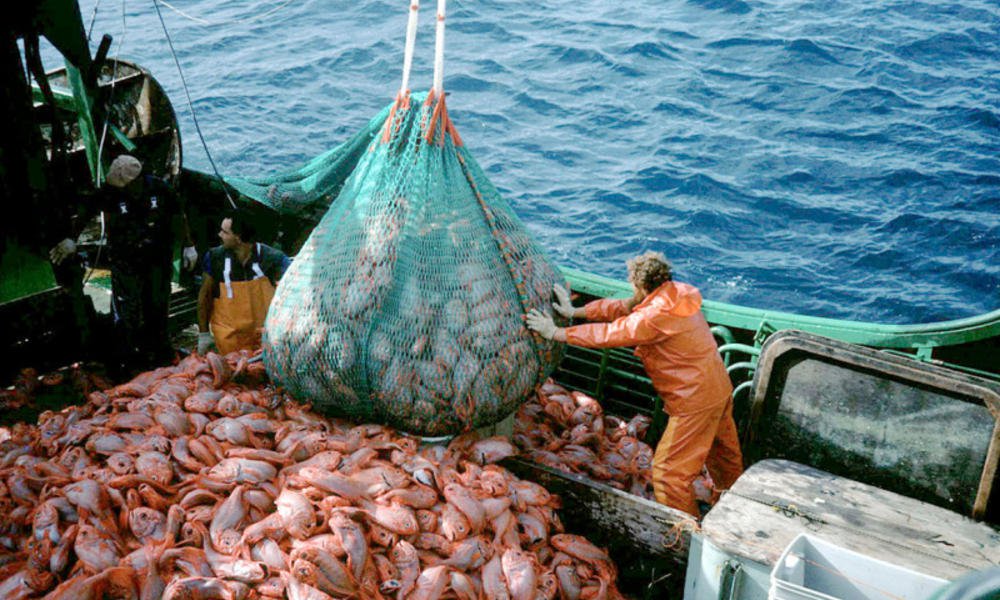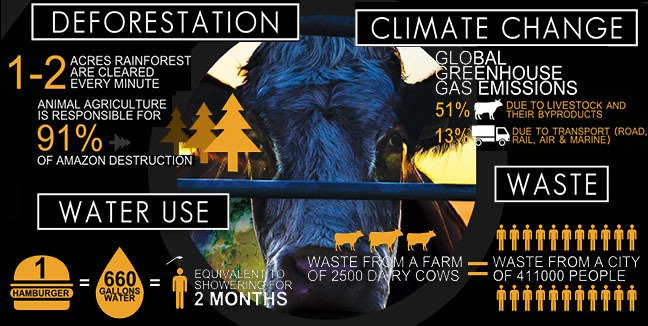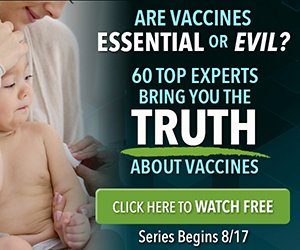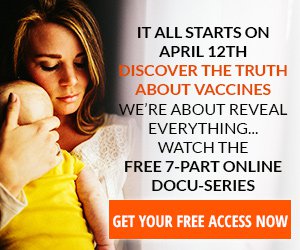
The government, mainstream media, and multiple environmental organizations are constantly driving our attention toward oil and gas, transportation, and many other industries that contribute to environmental degradation and destruction. How often do you hear that animal agriculture is the leading force behind all of this?
The environmental destruction that occurs as a result of animal agriculture is alarming, yet it tends to be swept under the rug. Environmental organizations often refuse to address this issue because it affects so many people and our understanding of how we live and thrive. Meat is a staple found on the tables in most houses, and it’s a huge money-maker (with a value of $1.4 trillion, to be exact), so many organizations choose to avoid the topic altogether.
We can no longer look the other way when it comes to the destruction of the environment. The Earth is our home, without which we have nowhere to thrive. Factory farming has become far too significant of an issue to ignore. It’s a leading cause of overfishing, wildlife destruction, deforestation, land degradation, and depletion of freshwater, and is responsible for 65% of all human-related nitrous oxide emissions and an absurd amount of methane and carbon dioxide emissions. It also, ironically enough, contributes to world hunger.
Let’s take a look at some of the main issues related to animal agriculture and the environment.
The Relationship Animal Agriculture Holds to Land
Livestock occupies 45% of Earth’s total land. Excessive land use directly contributes to land degradation and deforestation. For example, in the Amazon basin alone, approximately 70% of land that used to be forested is now used as pasture, and the remainder is largely used as feed crops.
Keep in mind that all of these animals need to be fed. So, when demand rises for meat, factory farms grow, increasing the overall number of animals used for human consumption. The more animals living at these farms, the more land that’s used to grow food solely to feed them. This food could be feeding hungry human beings all over the planet, but instead is used to fatten up the animals we consume.
In the US, livestock is fed 47% and 60% of all soy and corn production, respectively. Approximately 842 million people are suffering from hunger worldwide, a number that could be decreased if factory farms provided them with the same amount, or even just a fraction of the amount, that is fed to their animals. It’s expected that farmers will need to produce 50% more food by 2050 and that demand for meat and dairy will increase drastically, so this problem will not disappear on its own.
In addition, pretty much all of the soy and corn fed to these animals is genetically modified (approximately 90% for both crops), and these crops come with numerous environmental and health problems of their own. Since Monsanto has monopolized the U.S. farming industry, GMO crops are typically sprayed with their herbicide Roundup. As a result, weeds have begun to develop immunity to the spray, creating “super weeds,” an outcome that can significantly damage both the environment and the crop.
This monopoly promotes the cultivation of a single, uniform crop, otherwise known as monoculture, which can lead to a decline in biodiversity, as it can greatly impact population dynamics and ecosystem roles. Essentially, the more animals we eat, the more food we must use to feed them, and thus the more GM corn and soy we must grow, leading to further land degradation and environmental damage, not to mention the health issues they pose to humans.
We highly suggest watching: Cowspiracy
Water Depletion and Overfishing
Animal agriculture consumes a whopping 34-76 trillion gallons of water annually. Let’s put this into perspective: Adults typically drink two litres of water today, which translates to roughly half a gallon. The water used in average households is approximately 98 gallons per day. The amount of water required to make one apple is about 18 gallons. The water used to make one burger is 660 gallons.
Likewise, 1 pound of beef uses 1,799 gallons of water. This calculation includes irrigation of the grains and grasses used to feed the animal in addition to the water used for drinking and when processing. It’s not just beef, it’s all animal products. 1 pound of chicken uses 468 gallons of water, 1 pound of pork uses 576 gallons, 1 gallon of milk uses 880 gallons, and 1 pound of cheese uses 600 gallons.
How does that compare with plant-based products? 1 pound of corn uses 108 gallons of water, 1 pound of soybeans uses 216 gallons of water, 1 pound of potatoes uses 119 gallons, and 1 orange uses 13 gallons.
That’s not the only problem when it comes to animal agriculture and water. In 2010, 53% of fisheries were completely used up, and it’s only gotten worse, partially because factory fishers inadvertently kill and discard 200 million pounds of non-target fish daily. Over-utilizing these resources affects ecosystems negatively and puts societies at risk of losing valuable resources.

Meanwhile, 500 million tonnes of factory farm waste are produced in the U.S. annually and 35,000 miles of river across 22 U.S. states were polluted as a result in 2013. This waste is difficult to prevent and control given the exponential growth of the industry, and it won’t get any easier as demand rises. Farm animals produce 130 times more waste than humans; do we really need so many of them in order to feed ourselves?
Many people are happier and healthier eating plant-based diets, and you would reduce your environmental footprint significantly if you followed one. Even just cutting our meat, especially red meat, can reduce your environmental impact significantly. Giving up just beef would do more for the environment than if you stopped using your car entirely!
Check out this cookbook: Forks Over Knives – The Cookbook: Over 300 Recipes for Plant-Based Eating All Through the Year
Final Thoughts
It’s important that we educate one another on our environmental impact so we can try our best to reduce it. Even if you don’t want to go vegan entirely, just being mindful of this information and trying to reduce your intake of animal products is a big step in the right direction. It doesn’t have to be all or nothing.
Ultimately, we vote with our dollars, so we do have a power to make a difference. Without demand for animal products, we wouldn’t have these issues. So, if you want to reduce your ecological footprint, all you have to do is stop supporting companies that contribute to environmental destruction.
If you’re looking for some inspiration to eat more plant-based or go vegan, check out these CE articles:
6 Vegan Cookbooks You Need To Try This Summer!
16 Vegan One-Pot Recipes If You Are Considering Cutting Animals Out Of Your Diet
7 Simple & Delicious Vegan Slow Cooker Recipes
21 Easy Vegan Lunches To Take To Work
Watch The Truth About Vaccines
Why are vaccines the greatest controversy of the 21st century? Because it affects so many people and because there are lies being covered up.
An incredibly new docu series is exploring this entire subject. Bringing together experts in the field, doctors, scientists and more to explore the topic in a way that has never been done before.
Learn all their is to know about vaccines in The Truth About Vaccines. Get Access Now!
Source Article from http://feedproxy.google.com/~r/Collective-evolution/~3/wnqnYTzVL9g/
Related posts:
Views: 0
 RSS Feed
RSS Feed
















 August 13th, 2017
August 13th, 2017  Awake Goy
Awake Goy 



 Posted in
Posted in  Tags:
Tags: 
















